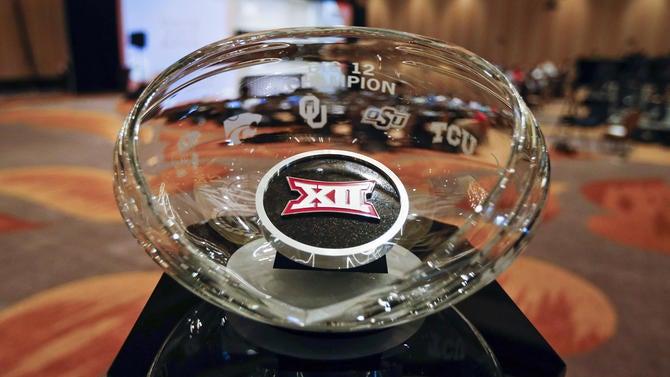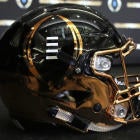The Big 12 has a unique opportunity to become the first conference to guarantee its two best teams meet in its re-instituted league championship game.
Whether that's an advantage for the suddenly re-energized conference is yet to be determined. The league announced Friday it would bring back its conference title game in 2017.
Division winners have met in each of the 68 other conference title games hosted by all leagues going back to 1992.
The NCAA passed legislation in January that was submitted by --- and essentially benefited -- the Big 12: Conferences with less than 12 teams are now allowed to hold a championship game between its top teams as long as it plays a full round-robin schedule.
The 10-team Big 12 is the only FBS conference in which all the teams play each other in league play.
Research by CBS Sports shows that, in the previous 15 Big 12 title games (1996-2010), matching the two best teams would have made little difference to the league's national championship hopes.
Ten times in those 15 years, the two top-ranked Big 12 teams in the AP Top 25 did not meet in the league championship game. Only in 2007 would a two-best matchup perhaps have made a difference.
The Big 12 has chosen to enter a space where the Power Five now sync up, each playing a 13th game in a league championship matchup. But in the history of the those 68 title games, the underdog has won slightly less than 30 percent of the time.
The Big 12 has had the most volatile championship game history. Six times in those 15 games (40 percent), the underdog either covered or won outright in the old 12-team league.
Due to championship game upsets, the league lost national championship shots in 1996, 1998 and 2007.
The SEC has been the most stable in league title games. Only three times in 24 years has it lost a national championship contender.
Big 12 commissioner Bob Bowlsby said "in all likelihood" his league would split into two five-team divisions and continue to play a full round-robin schedule. But that doesn't preclude the league from matching its two best teams from one 10-team table.
The conference has played as a single 10-team entity since 2011.
"When you don't play a round-robin, your schedule is significantly reduced in terms of strength," Bowlsby said.
Either way, the league is guaranteed a rematch in the conference championship game. That occurred six times in those previous 15 championship games (2000, 2001, 2002, 2005, 2007, 2008). Only once did the teams split the two meetings. In 2001, Colorado upset Texas in the Big 12 title game after losing the regular-season meeting.
"We could end up playing just like we're playing now and select our two highest-ranked teams. It's possible," Bowlsby said. "It's a regular-season rematch. You run the risk of [the teams] being closely clustered late in the season."
Had the two best teams met last season, Oklahoma would have had to defeat Oklahoma State two weeks in a row to reach the College Football Playoff.
That would raise new issues. The Sooners won handily 58-23 in Nov. 28 in Stillwater. Would anything less than a five-touchdown repeat win signal a weakness to the selection committee?
As it stood, OU dropped from No. 3 to No. 4 in the CFP Rankings after not playing on championship Saturday.
Best case for the Big 12: The league matches two teams annually with no more than one loss. That has the best chance of impressing the CFP Selection Committee.
The round-robin format guarantees two undefeated teams cannot meet.
Compare that to the old Big 12: In the conference's previous 15 championship games, a division winner with at least two losses participated each year.
The Big 12 already has weighed these stinging conference title game upsets that cost the league a national championship berth:
In 1996, No. 3 Nebraska was upset by unranked South Division champ Texas in the first Big 12 title game 37-27. Had the Huskers won, they could -- as the defending national champs -- have played No. 1 Florida State in the Sugar Bowl. A win there and Nebraska could be looking at four consecutive national championships (1994-1997). The same could be said if the Huskers played the best team available -- No. 7 Colorado. Nebraska had beaten the Buffs the week before, 17-12.
In 1998, No. 2 Kansas State and No. 10 Texas A&M were the Big 12's two best teams. The Wildcats lost a shot at the first BCS Championship Game when they were upset by the Aggies in overtime.
In 2007, No. 1 Missouri lost to Oklahoma by three touchdowns in the Big 12 championship game. If the two best teams had met, Missouri would have played Kansas -- No. 5 in the BCS at the time -- in a rematch. It's possible no matter what the result in that game, the Big 12 would have had a team in the BCS championship.
In the five years since doing away with the championship game, the Big 12 has played for the national title once (Oklahoma, 2015 College Football Playoff). Twice in 2011 (Oklahoma State in the BCS) and 2014 (Baylor and TCU in the CFP), the league narrowly missed championship berths.
While no determination has been made, it assumed the CFP rankings would be used to match the two best teams in the conference.
Because of NCAA deregulation, conferences are now allowed to match their two best teams in their league championship game. While the Big 12 ponders its structure for its re-instituted game that begins in 2017, here's a look at how those previous championship games would have looked matching the two highest-ranked teams in the AP Top 25.
1996 -- Texas 37, No. 3 Nebraska 27
Best possible matchup: No. 3 Nebraska vs. No. 7 Colorado
Would it have made a difference? No. A CU win in a rematch (a week after a 17-12 Nebraska win in Lincoln) most likely would have left the Buffs out of a shot at No. 1 Florida State. Nebraska would have had to win either way.
Fallout: Upset loss knocked Nebraska out of possible title shot vs. Florida State in Sugar Bowl.
1997 -- No. 2 Nebraska 54, No. 14 Texas A&M 15
Best possible matchup: No. 2 Nebraska vs. No. 10 Kansas State
Would it have made a difference? No.
Fallout: Nebraska used the win to help capture its third national championship in four years in Tom Osborne's final season.
1998 -- No. 10 Texas A&M 36, No. 2 Kansas State 33 (OT)
Best possible matchup: Same.
Fallout: With a win, K-State would have played Tennessee for the first BCS title.
1999 -- No. 3 Nebraska 22, No. 12 Texas 6
Best possible matchup: Nebraska vs. No. 8 Kansas State
Would it have made a difference? No.
Fallout: The Huskers, 11-1 and No. 3 in the BCS, had no hope to play for the national championship. Undefeated Florida State and Virginia Tech finished 1-2 in the BCS.
2000 -- No. 1 Oklahoma 27, No. 8 Kansas State 24
Best possible matchup: Same.
Fallout: OU completed a 13-0 national championship by beating Florida State in the Orange Bowl.
2001 -- No. 9 Colorado 39, No. 3 Texas 37
Best possible matchup: No. 3 Texas vs. No. 6 Nebraska
Would it have made a difference? No. A Horns-Huskers winner most likely would have advanced to play for it all in a more traditional manner than below.
Fallout: A BCS nightmare. Nebraska snuck into the BCS title game against Miami despite not winning its division or league and losing to eventual Big 12 champion CU by 26 points.
2002 -- No. 8 Oklahoma 29, No. 12 Colorado 7
Best possible matchup: No. 8 Oklahoma vs. No. 6 Kansas State
Would it have made a difference? No.
Fallout: The Big 12 was out of the running after Miami and Ohio State finished undefeated.
2003 -- No. 13 Kansas State 35, No. 1 Oklahoma 7
Best possible matchup: Same.
Fallout: The day the BCS (should have) died. OU lost by four touchdowns to K-State and remained No. 1 in the BCS. Incredibly, the Sooners still played for the BCS title, losing by a touchdown to LSU. That year USC shared the championship finishing No. 1 in the AP Top 25.
2004 -- No. 2 Oklahoma 42, Colorado 3
Best possible matchup: No. 2 Oklahoma vs. No. 6 Texas
Would it have made a difference? No.
Fallout: The win pushed the Sooners into the BCS title game in South Florida. USC battered OU 55-19 for the Pac-10/12's last championship.
2005 -- No. 2 Texas 70, Colorado 3
Best possible matchup: No. 2 Texas vs. No. 18 Texas Tech
Would it have made a difference? No.
Fallout: The Longhorns bulldozed their way to a national championship, later beating USC.
2006 -- No. 8 Oklahoma 21, No. 19 Nebraska 7
Best possible matchup: No. 8 Oklahoma vs. No. 17 Texas Tech
Would it have made a difference? No.
Fallout: Every team in the Big 12 had at least two losses headed into the league championship game. No title implications.
2007 -- No. 9 Oklahoma 38, No. 1 Missouri 17
Best possible matchup: No. 1 Missouri vs. No. 7 Kansas
Would it have made a difference: Possibly.
Fallout: A KU-Missouri rematch a week after the regular-season finale may have produced a BCS title game berth for the league regardless, especially if the Tigers won.
2008 -- No. 4 Oklahoma 62, No. 19 Missouri 21
Best possible matchup: No. 4 Oklahoma vs. No. 8 Texas Tech
Would it have made a difference: No.
Fallout: A rematch with the Red Raiders wouldn't have made a difference in the final BCS standings (assuming the Sooners won). Oklahoma finished No. 1 and lost to Florida in the BCS title game.
2009 -- No. 3 Texas 13, No. 21 Nebraska 12
Best possible matchup: Same.
Fallout: The Longhorns advanced to lose to Alabama in the BCS title game.
2010 -- No. 10 Oklahoma 23, No. 13 Nebraska 20
Best possible matchup: Same.
Fallout: No impact on the national race with Oregon and Auburn finishing undefeated. Every Big 12 team that year lost at least two games.






















